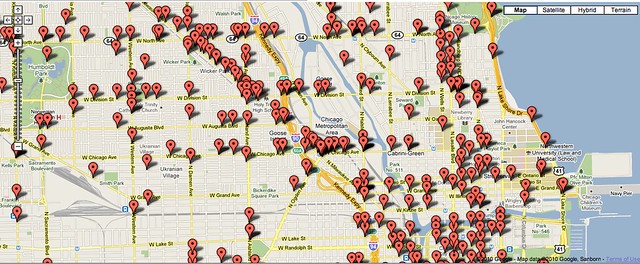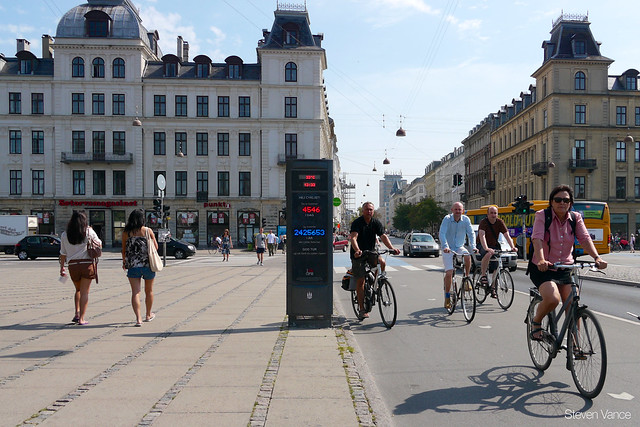This is the edited text of a speech I gave Monday night for the City of Chicago's Earth Data Celebration about the use of data in measuring sustainability performance measures in Chicago.
As deputy editor of Streetsblog Chicago, and co-editor of Grid Chicago before that, one question I field quite often from readers is, "How many people are biking in Chicago?" Frankly, it's nearly impossible to tell.
In 2006, the City of Chicago released the Bike 2015 Plan with two overarching goals: to increase bicycle use so that 5 percent of all trips less than five miles are by bicycle, and to reduce the number of bicycle injuries by 50 percent from current levels. Injuries are tracked consistently with crash reports and ER admittance records. Last year, the city commissioned the Active Transportation Alliance and the UIC Urban Transportation Center to analyze those; a report should be issued this year. But tracking bicycle use, be it the number of people bicycling on any given day, or the change in bicycling year over year, has been more elusive.
The crash and injury data is easy to obtain from the Illinois Department of Transportation, but it lacks a key complementary dataset: exposure. How many cyclists are out there, for how long, and where? I made a bike crash map in 2011, but without that information, I wasn't able to tell people which intersection was the most dangerous when they asked about places they should avoid. I could only tell them which places had the most crashes, because I didn't know how many people were bicycling by. The exposuire information would be factored into crash location analysis to help prioritize which locations need safety improvements the most.
There are many methods to track exposure, and new ones are coming to the forefront.
Traffic counting devices that use pneumatic tubes are much less expensive than they used to be and now cost about $150. Permanently installed counters that can track bikes cost about $2,000. There are video-based counters that, with a single camera, can count all the users -- motorists, bicyclists, pedestrians -- at one intersection. These can be rented by the minute. A growing trend in cities that consider themselves bike-friendly is to install "eco-totems," or vertical displays that show the real-time count of cyclists who've passed that point. Beyond the data collection, this has the benefit of telling people riding their bikes that "they counted."
If you've enabled location services on your smartphone, then your phone is keeping a log of everywhere you're going. One new app, "Moves," from Finland, reads your location log and determines which trips you made were by foot, by bike, or by motorized transport. You can change the determination if it's wrong. An app called Cycletracks was used in San Francisco to track where people biked and when. Then there are devices like Mote.0.bike, created by students and faculty at the School of the Art Institute of Chicago to be a comprehensive environmental survey device, measuring ambient noise, lighting, and carbon monoxide as well as location.
Traditional methods of counting include travel surveys, in which all members of a household fill out a form about all of their travel activities for a day or a week. The Chicago Metropolitan Agency for Planning conducted a travel survey in 2008 and found that 1.3 percent of all trips in Cook County were by bike. The report didn't separate Chicago from Cook County, but the data is available and could be crunched again. These surveys involve a lot of manual work on the part of respondents and researchers, however, and suffer from small sample sizes.
Chicago should experiment with some of the electronic counting methods in order to measure the performance of the Bike 2015 Plan's goals. This information can also be used to measure the performance of the Chicago Climate Action Plan, which sets out to reduce emissions by 80 percent in Chicago by 2050. The plan states that every million trips by bike and by walking reduces emissions by 10,000 metric tons of carbon dioxide, but that in 2010, the number of trips by bike and by walking was only half a million. So there's a lot of counting to do from now until 2050!






